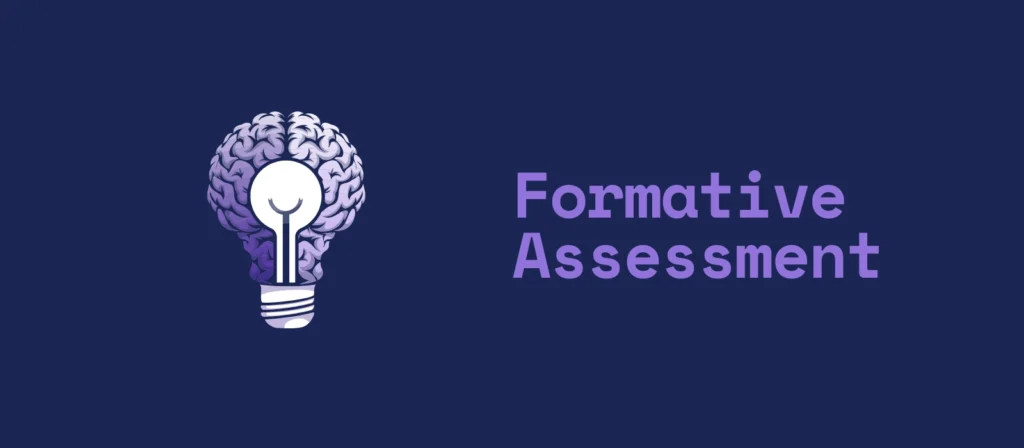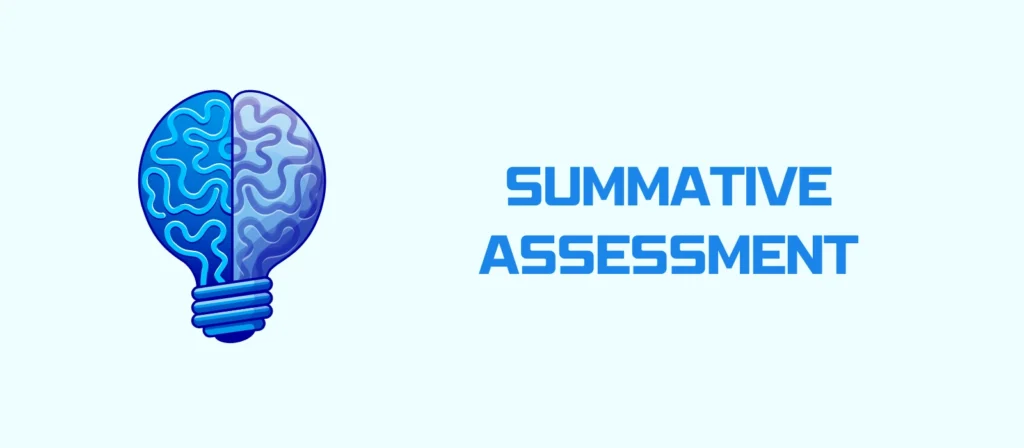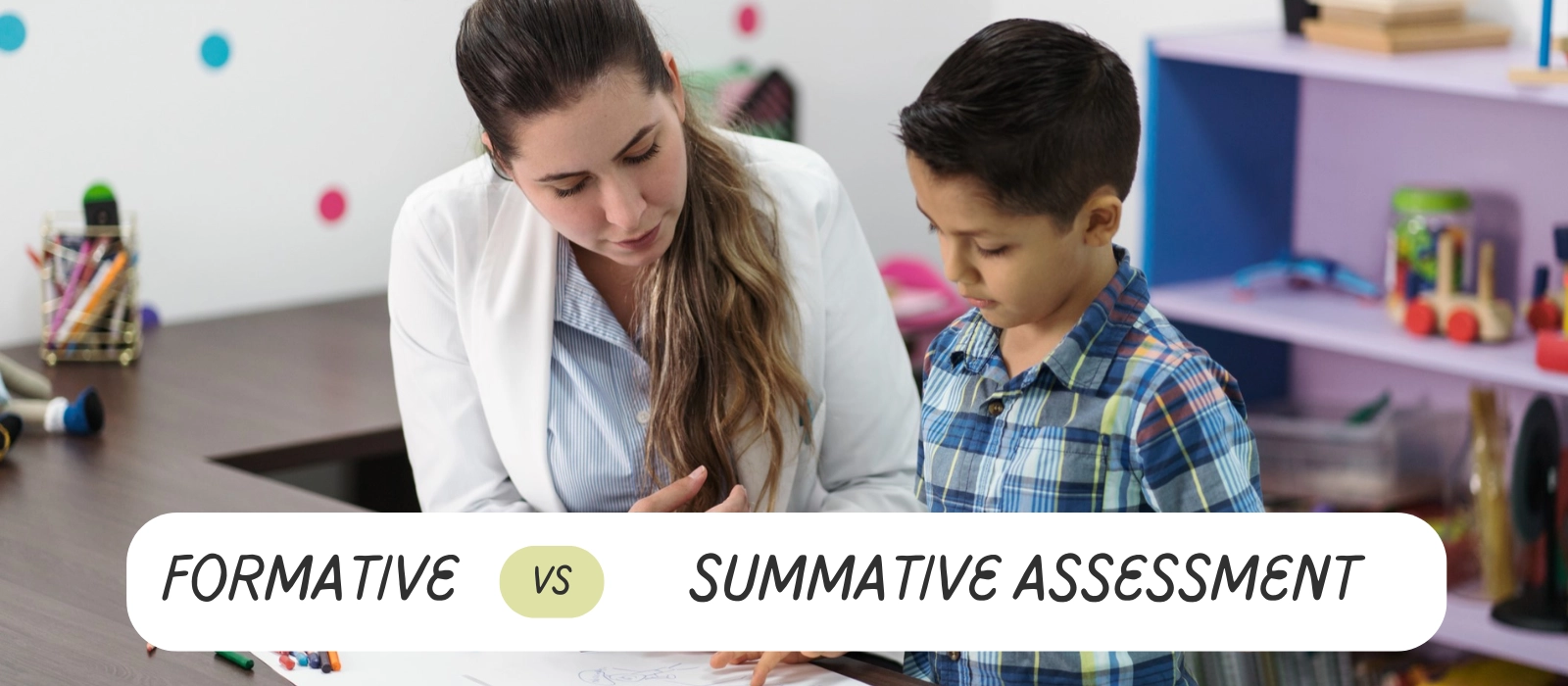Are your students truly learning what you’re teaching? Are their emotional, social, and academic developments being accurately tracked? Or are you simply testing for the sake of grades? Many educators, kindergarten directors, and procurement specialists struggle to answer one fundamental question: formative vs summative assessment—how do you choose the right one, and why does it matter? When assessments go wrong, classrooms lose clarity, progress gets lost in numbers, and ultimately, children miss out on growth opportunities.
The difference between formative and summative assessment is not just technical—it’s foundational. Formative assessment helps guide and improve learning in real time, while summative assessment measures the results of that learning at the end of a unit or course. Choosing the right method ensures your teaching is both responsive and accountable, especially in early childhood education where every learning moment counts.
Understanding these two types of assessment is not only critical for educators but also for those involved in school planning, classroom setup, and kindergarten resource procurement. If you’re working with or managing an educational environment, making the right choice between formative and summative strategies can lead to more effective teaching, smarter classroom design, and better student outcomes.

What Is Formative Assessment?
Formative assessment is a process—not a single test. It’s designed to provide continuous feedback to both teachers and students during the learning process. The primary goal of formative assessment is to improve student learning and instruction in real time. Rather than waiting until the end of a unit or semester, teachers use formative assessment techniques to monitor student progress regularly and make adjustments as needed.
This type of assessment is highly flexible and often informal. It can take many forms: open-ended questions during class discussions, quick polls or thumbs-up/down activities, peer reviews, exit tickets, or even simple one-on-one observations. These techniques help educators understand what students are learning, what they’re struggling with, and how to adjust their approach accordingly.
One of the key benefits of formative assessment is its focus on learning rather than grading. For example, a kindergarten teacher might notice that children are having trouble with spatial awareness during a block-building activity. Rather than assigning a grade, the teacher may adjust the day’s plan to include guided practice in organizing shapes. In this way, the feedback loop is immediate, actionable, and supportive of developmental learning.
Research supports the effectiveness of formative assessment in early education. According to this study on formative techniques, students who receive regular formative feedback perform significantly better in both academic and behavioral outcomes.
In early childhood education, where cognitive and emotional development are deeply intertwined, formative assessment helps teachers observe not just what children know, but how they’re learning. It promotes a nurturing learning environment and ensures that instruction is responsive to each child’s unique needs.
Moreover, formative assessment encourages a growth mindset in children. Because feedback is framed as a tool for improvement rather than judgment, children are more likely to stay motivated, explore ideas, and take academic risks. This emotional safety is especially critical in preschool and kindergarten settings.
To make the most of formative assessment, educators need an environment that supports observation, interaction, and small group instruction. This is where classroom layout and furniture design come into play—a theme we’ll revisit later in connection with how XIHA Furniture supports educational effectiveness.

What Is Summative Assessment?
Summative assessment is a high-stakes evaluation that typically occurs at the end of an instructional unit, term, or academic year. Unlike formative assessment, which supports learning as it happens, summative assessment measures the outcomes of the learning process. It is used to determine whether educational goals and standards have been met. In the debate of formative vs summative assessment, this type is what most people traditionally associate with school testing.
Examples of summative assessments include standardized tests, final projects, midterm or end-of-term exams, formal presentations, and cumulative portfolios. These assessments often carry a significant weight in grading systems, which can impact a student’s future academic opportunities.
One of the defining characteristics of summative assessment is its finality. Once the test is taken or the project submitted, the student generally receives a score or grade with little opportunity for revision or feedback. In this sense, summative assessment acts as a summary judgment on student achievement.
In early childhood education, summative assessment can still play a role, though it must be carefully adapted. For instance, developmental checklists, skill rubrics, and end-of-semester performance reviews are more appropriate than formal written tests. These tools offer a snapshot of children’s cognitive, physical, and socio-emotional growth.
While summative assessment may lack the immediate feedback loop of formative assessment, it is essential for accountability. Schools, districts, and policymakers rely on summative data to evaluate curriculum effectiveness, allocate funding, and set educational standards. Parents also use this information to track their child’s learning outcomes over time.
However, relying too heavily on summative assessments—especially in isolation—can be detrimental. If educators focus only on test results, they may overlook the developmental needs of individual students. This is particularly problematic in kindergarten settings, where holistic development is critical.
The balance between formative vs summative assessment is vital. Effective classrooms use both types strategically, with formative assessment guiding daily instruction and summative assessment validating long-term progress. When used together, they provide a more complete and accurate picture of student learning.
Here’s an excellent comparison of summative and formative practices from The Glossary of Education Reform.
To effectively implement summative assessments, classrooms must be equipped with the right tools and spaces—quiet zones for reflection, storage for portfolios, and display areas for student work. That’s where thoughtful furniture planning becomes essential, reinforcing the environment’s role in high-quality assessment.
Key Differences Between Formative and Summative Assessments
When comparing formative vs summative assessment, it’s crucial to understand the contrasting goals, tools, timing, and impacts on learning. Though both are vital parts of the educational process, their functions are distinctly different—and knowing how to differentiate between formative assessment and summative assessment can shape better teaching strategies and classroom outcomes.
Here’s a breakdown of the major differences between formative and summative assessments:
| Criteria | Formative Assessment | Summative Assessment |
|---|---|---|
| Purpose | To monitor and improve learning as it happens | To evaluate what students have learned after instruction |
| Timing | Ongoing, frequent | End of a unit, term, or course |
| Feedback | Immediate, diagnostic, constructive | Final, evaluative, usually scored |
| Format | Informal observations, quizzes, exit tickets | Exams, projects, standardized tests |
| Focus | Learning process | Learning outcome |
| Use | Guides teaching strategy | Measures achievement |
| Student Role | Active participant in feedback loop | Subject of evaluation |
The difference between formative and summative assessment lies not only in when they are used, but also in how they impact instruction and engagement. In formative assessment, the learner is empowered. In summative assessment, the learner is evaluated.
One effective way to view the formative vs summative assessment debate is through a real-world analogy. Imagine learning to play the piano. A teacher correcting your finger placement during practice is formative assessment. A final recital performance judged by an audience is summative assessment. Both are essential—but they serve different purposes.
Educators often find the integration of formative and summative assessments to be the most powerful. By using formative feedback to steer day-to-day instruction, and summative assessment to confirm learning goals, teachers build a cycle of continuous improvement.
If you’re a kindergarten director or educational procurement officer, understanding these differences can guide you in selecting the right classroom tools and planning assessments that align with early learning goals. Whether you’re evaluating a vendor or designing a curriculum, every decision should factor in the difference between formative and summative assessments.
Why Both Assessments Are Essential in Early Education
When it comes to designing a developmentally appropriate curriculum for young learners, relying solely on either formative or summative assessments would be a mistake. Understanding how formative vs summative assessment complement one another is key to building a holistic learning experience that nurtures curiosity, measures progress, and ensures readiness for the next level.
In early childhood education, formative assessment serves as a responsive mirror to a child’s developmental journey. It enables teachers to catch early signs of learning challenges, social-emotional delays, or misunderstandings. On the other hand, summative assessment provides accountability and benchmarks that stakeholders—school directors, parents, policymakers—can rely on to evaluate the effectiveness of instruction.
The debate around formative vs summative assessment often centers on which is better. But in practice, both types of assessment are vital, especially for children ages 3 to 6. Young children learn in bursts. Their progress may not follow a linear path. Formative assessment allows educators to ride these waves with flexibility, while summative assessment ensures that essential learning targets have been met.
For example, a preschool teacher might use daily formative assessments like observation logs, phonics games, or self-assessment smiley charts to track literacy readiness. At the end of the term, she might compile a summative portfolio with drawings, letters, and oral recordings to share with parents and school administrators.
This dual strategy—grounded in the formative vs summative assessment framework—offers the best of both worlds. Teachers stay connected to the learner’s growth, while the institution maintains clear documentation of progress and areas that require improvement.
Multiple studies, such as this research overview on early learning assessments, stress that effective learning in the early years comes from this blended assessment model. A classroom equipped to support both types of assessment will often have varied zones—quiet corners for observation, collaborative areas for group work, and open spaces for large motor activities.
This is precisely where the physical environment intersects with pedagogy. Classroom furniture and design play a vital role in enabling real-time feedback loops (formative) and structured evaluation (summative). At XIHA Furniture, we understand how critical these spaces are. From modular activity tables to creative art stations and multi-use display boards, our furniture collections are crafted to align with how young children learn and how teachers assess.
When to Use Formative vs Summative Assessment
Deciding when to use formative vs summative assessment depends on your educational goals, classroom dynamics, and what kind of feedback you’re seeking. The strategic timing of each assessment type can dramatically influence learning outcomes, classroom engagement, and the effectiveness of instructional methods—especially in early childhood education where formative vs summative assessment practices shape the foundation of lifelong learning.
Formative assessment should be used throughout daily instruction. Think of formative assessments as real-time diagnostics. Use them when you want to:
- Adjust lesson plans based on student understanding
- Provide immediate feedback and encouragement
- Guide differentiated instruction in small groups
- Identify learning gaps as they emerge
Daily observations, interactive activities, reflective journals, and peer feedback are ideal tools for formative assessment. For example, during a language lesson in a kindergarten classroom, teachers can use hand signals or mini-whiteboards to check comprehension instantly—this is a textbook use of formative vs summative assessment strategies.
Summative assessment, by contrast, should be scheduled at the end of a learning cycle. Use summative assessments when your goal is to:
- Measure learning outcomes and benchmark performance
- Evaluate the success of a curriculum or teaching strategy
- Communicate student progress to parents and administrators
- Inform institutional decisions like funding or curriculum changes
Typical examples include final exams, cumulative projects, and semester-end reports. In early education, summative assessments may include developmental profiles, readiness checklists, and end-of-unit displays of learning.
A well-balanced approach involves using both types of assessment at the right times. For instance, in a thematic unit on “Seasons,” formative assessment might include student drawings, storytelling, and science journals throughout the month. At the end of the unit, a summative project may involve presenting a seasonal diorama, allowing children to demonstrate cumulative understanding.
In every stage of instruction, the interplay between formative vs summative assessment can elevate teaching outcomes. According to Education Corner, using formative assessments in advance of summative assessments leads to stronger academic performance and better student confidence.
Timing is everything. But so is the environment. Well-structured classrooms with defined zones for group work, independent tasks, and assessment activities create space for effective formative vs summative assessment cycles. At XIHA Furniture, our modular solutions help educators build classrooms where assessments aren’t just events—they’re experiences.
Real Classroom Examples of Formative vs Summative Assessment
To fully understand the value of formative vs summative assessment, we must explore how they operate in real classroom settings. Practical examples not only clarify theory but also empower educators to implement these strategies with confidence. In early childhood classrooms, especially those focused on inquiry-based or Montessori-style learning, both formative and summative assessments are deeply woven into the learning fabric.
Example 1: Literacy Development in Kindergarten
In a literacy-focused kindergarten classroom, formative assessment takes the shape of daily sight word games, phonetic awareness check-ins, and individual storytelling sessions. A teacher might use magnetic letters and observe how a child builds CVC (consonant-vowel-consonant) words. Throughout the week, notes and audio recordings are collected as part of formative feedback. This supports the student’s growth while guiding the teacher’s planning.
At the end of the month, a summative assessment occurs. Children are asked to read a series of high-frequency words from a leveled list and complete a short comprehension worksheet. These summative results are shared with parents and added to student portfolios, offering a benchmark of literacy progress. This dual-use of formative vs summative assessment ensures that daily feedback informs instruction, while long-term evaluations drive accountability.
Example 2: Mathematics Learning Stations
In a math lesson centered around number recognition and counting, formative assessment is applied during learning stations. As children sort number cards, count beads, and play math games, the teacher takes observation notes using a rubric aligned with early learning standards. These are formative assessment moments in action.
At the end of the unit, students complete a summative assessment: a short task where they identify numbers, complete a pattern, and solve basic addition problems using manipulatives. Comparing this summative outcome with the earlier formative data reveals whether instruction was successful and which students need intervention. The formative vs summative assessment relationship is not linear—it’s cyclical.
Example 3: Science and Inquiry Exploration
Formative vs summative assessment also appears vividly in inquiry-driven subjects like science. During a unit on plant life, students might grow bean sprouts in small pots. Each day, they record changes, draw diagrams, and share hypotheses. The teacher uses these artifacts as formative evidence of scientific thinking.
For the summative assessment, students create a visual presentation or booklet summarizing the plant life cycle, using real vocabulary and explaining stages in their own words. These summative tasks allow educators to see the culmination of thinking developed across many formative checkpoints.
Example 4: Social-Emotional Learning (SEL)
Even social-emotional competencies can be measured through formative vs summative assessment. Teachers may use behavior charts, emotion thermometers, and peer interactions as formative assessment data. They note how children manage conflict, express emotions, or practice empathy.
Later, during student-led conferences or end-of-year reflections, teachers may use a summative SEL checklist or rubric based on national standards to determine whether children demonstrate age-appropriate skills in self-regulation and social interaction.
Discover more classroom examples of assessment types.
In each example above, the effective use of formative vs summative assessment creates a feedback-rich environment that supports whole-child development. Whether guiding instruction or evaluating program quality, assessment types must be supported by flexible classroom infrastructure. At XIHA Furniture, we design multi-functional furniture—from observation corners to group activity stations—that make it easier to embed assessments into daily routines.

The Pros and Cons of Formative vs Summative Assessment
Understanding the pros and cons of formative vs summative assessment is crucial for educators, school administrators, and early childhood curriculum developers. While both assessment types play essential roles in the classroom, they serve different purposes and come with different strengths and limitations. The key is to recognize when and how to apply each method to support high-quality learning outcomes.
Pros of Formative Assessment
Formative assessment offers significant advantages for real-time instruction. Among the most cited benefits are:
- Immediate Feedback: Teachers receive ongoing insights into student progress and can adjust teaching on the fly.
- Student Engagement: Students are involved in their own learning through peer assessment, self-reflection, and teacher interactions.
- Differentiated Instruction: Because formative assessments are frequent, teachers can adapt lessons based on diverse learning needs.
- Fosters Growth Mindset: Encourages risk-taking, creativity, and persistence through non-graded, feedback-driven evaluations.
- Supports Continuous Learning: By using formative vs summative assessment together, teachers create a rhythm of feedback that keeps learning on track.
However, while formative assessment is incredibly useful, it also has its drawbacks.
Cons of Formative Assessment
- Time-Consuming: Gathering and interpreting daily student data can be labor-intensive.
- Subjectivity Risk: Observational assessments may vary depending on the teacher’s experience and perception.
- Requires Training: Not all teachers are adequately trained in designing or analyzing formative assessments.
Despite these cons, most educators agree that the advantages of formative assessment significantly outweigh the drawbacks—especially when used alongside summative assessments.
Pros of Summative Assessment
In the context of formative vs summative assessment, summative tools offer indispensable benefits:
- Benchmarking Performance: Summative assessments provide a snapshot of student achievement against standards.
- Accountability and Reporting: Ideal for communicating results to parents, school boards, and accreditation agencies.
- Clear Metrics: Easier to quantify and analyze performance data across student populations.
- Long-Term Planning: Summative data helps inform curriculum design and school-wide instructional planning.
Cons of Summative Assessment
- Lack of Feedback: By nature, summative assessments offer little opportunity for students to learn from mistakes.
- High Pressure: Can create anxiety for young learners, especially if too frequent or rigid.
- Narrow Focus: Often emphasizes rote memorization or test-taking skills over deep learning.
- Missed Nuance: A single test may not reflect the full scope of a student’s abilities or growth trajectory.
This comparison of formative vs summative assessment shows why integrating both methods is essential. Over-reliance on summative evaluation can limit classroom adaptability, while depending only on formative strategies may hinder institutional reporting and long-term tracking.
For early childhood educators and procurement officers, recognizing the strengths and weaknesses of formative vs summative assessment can also influence classroom layout, staffing, and material selection. At XIHA Furniture, we design spaces that support both reflective observation and formal evaluation—allowing for dynamic and responsive assessment practices.
Summary Table: Pros and Cons of Formative vs Summative Assessment
| Aspect | Formative Assessment | Summative Assessment |
|---|---|---|
| Purpose | Improve learning in real time | Evaluate final learning outcomes |
| Feedback | Ongoing and immediate | Final and often delayed |
| Use | Instructional guidance | Curriculum validation |
| Student Involvement | High (interactive) | Low (evaluative only) |
| Strengths | Personalized, adaptive, responsive | Measurable, reportable, structured |
| Weaknesses | Time-consuming, less standardized | Stressful, lacks immediate feedback |
How Formative and Summative Assessments Impact Student Learning
The impact of formative vs summative assessment on student learning cannot be overstated—especially in early childhood education where foundational skills are built and reinforced every day. By understanding how formative and summative assessments affect behavior, cognition, motivation, and academic growth, educators can fine-tune their strategies to better serve the developmental needs of every child.
Formative assessment is designed to shape the learning process as it unfolds. It impacts students by providing continuous feedback, reducing learning anxiety, and promoting reflective thinking. When students receive constructive, real-time feedback, they develop metacognitive skills—the ability to think about their own learning. This form of assessment builds confidence and resilience in young learners.
For example, a teacher noticing a student struggling with spatial relationships during a building block activity can immediately step in, offer guidance, and note progress. This is a clear use case where formative vs summative assessment shows its formative strength—adaptive, targeted, and immediately beneficial.
Summative assessment, on the other hand, affects students by offering a concrete measure of learning outcomes. It motivates goal-setting and long-term retention. For some children, the challenge of a summative task—like presenting a science model or completing a literacy portfolio—can foster focus and perseverance. However, it’s essential that summative assessments be developmentally appropriate to prevent stress or discouragement.
Combining formative and summative assessments creates a well-rounded learning ecosystem. The frequent checkpoints of formative assessments allow educators to tailor instruction, while the periodic structure of summative assessments ensures accountability and visibility of progress. In the context of formative vs summative assessment, this balanced model promotes academic equity by addressing both individual needs and standardized benchmarks.
A 2022 report from Brookings emphasizes that hybrid assessment strategies—blending formative and summative methods—improve not just academic outcomes, but also student engagement and emotional well-being. Especially in early years, where children rely heavily on feedback, the formative component is crucial.
Furthermore, the way formative vs summative assessment is delivered can influence a student’s perception of learning. Flexible, child-friendly classroom environments are more conducive to formative approaches, while clear, organized spaces support focused summative tasks. That’s why the role of learning environment design—like the modular furniture solutions from XIHA Furniture—is indispensable in modern kindergarten classrooms.
The impact of formative vs summative assessment extends beyond scores and checklists. It transforms how students interact with knowledge, with their peers, and with themselves as learners.
Summary Table: How Formative vs Summative Assessment Affects Learning
| Impact Area | Formative Assessment | Summative Assessment |
|---|---|---|
| Cognitive Growth | Builds real-time learning connections | Consolidates understanding post-instruction |
| Emotional Development | Reduces anxiety, fosters motivation | Can create stress, but reinforces achievement |
| Behavioral Skills | Encourages participation and exploration | Supports persistence and responsibility |
| Academic Outcomes | Enhances individual performance | Benchmarks group-wide progress |
| Feedback Quality | Instant, actionable, personalized | Final, standardized, evaluative |
Formative vs Summative Assessment in Kindergarten Accreditation
In the context of kindergarten accreditation, understanding formative vs summative assessment is essential. Accrediting bodies often require early childhood programs to demonstrate how they monitor, document, and support student learning—and this is where the strategic use of formative and summative assessments becomes a cornerstone of institutional credibility.
Many accreditation frameworks, such as those from the National Association for the Education of Young Children (NAEYC) in the U.S. or the Canadian Child Care Federation (CCCF), stress the importance of continuous improvement, outcome documentation, and individual child portfolios. These are all practices where formative vs summative assessment play critical roles.
Formative assessment, for example, supports accreditation by ensuring that teachers are actively documenting developmental progress in real-time. Observational checklists, daily logs, interactive journals, and learning stories are all formative tools used to track children’s growth in language, cognitive, motor, and social-emotional domains.
Summative assessment, meanwhile, helps meet the accountability and reporting standards required by accreditation bodies. Periodic reports, development milestone reviews, and end-of-term progress summaries are forms of summative assessment that demonstrate program quality, consistency, and effectiveness.
When a kindergarten applies for accreditation, the evaluation team typically reviews how assessment data is collected, how it informs teaching, and how it’s shared with stakeholders. A balanced and documented approach to formative vs summative assessment is seen as a hallmark of quality.
In fact, some accrediting organizations go further by requesting sample child portfolios, evidence of differentiated instruction based on assessment, and summaries of how classroom furniture or physical layout support assessment practices. At XIHA Furniture, we help schools and centers prepare for such reviews by offering customizable layouts that facilitate both ongoing formative assessment and structured summative evaluations.
Proper use of formative vs summative assessment also ensures equity and inclusion—two pillars of accreditation. By continuously monitoring each child’s development and following up with formal evaluations, educators can ensure all learners, regardless of ability or background, are progressing.
In summary, formative vs summative assessment is not just an educational concept—it is a professional standard. Accreditation agencies increasingly recognize that well-implemented assessment strategies lead to higher-quality learning environments, better teacher performance, and improved child outcomes.
How to Train Teachers to Balance Both Assessments
To successfully implement formative vs summative assessment in the classroom, teachers need structured training that equips them with both the mindset and the practical tools to balance these approaches effectively. Many early childhood educators enter the field with strong instincts for nurturing and observation, but without systematic support, even the most passionate teacher may struggle to manage the nuances of using formative and summative assessments in tandem.
Step 1: Build Conceptual Understanding
The first step in training teachers is developing their foundational understanding of formative vs summative assessment. This includes:
- Definitions and key differences
- Real-world classroom applications
- Case studies of successful implementation
Interactive workshops, professional development modules, and team teaching sessions can be used to present these concepts. Visual models, such as Venn diagrams and scenario-based comparisons, help educators visualize when to use formative vs summative assessment for maximum impact.
Step 2: Provide Assessment Tools and Templates
Teachers need reliable, easy-to-use tools for data collection. These might include:
- Formative tools: Observation checklists, quick response forms, digital note apps
- Summative tools: Standardized rubrics, project scorecards, evaluation summaries
Training should focus not only on how to use these tools, but how to analyze the resulting data to inform instruction. A training module might include a mock observation cycle followed by a simulated parent-teacher conference using both formative and summative data.
Step 3: Integrate Assessment Into Daily Practice
For teachers to confidently apply formative vs summative assessment, they must see how it fits seamlessly into their teaching routines. This includes:
- Embedding formative assessments into storytelling, group play, and learning centers
- Scheduling summative assessments strategically, avoiding cognitive overload
- Creating routines for quick daily reflections and end-of-week reviews
At this stage, classroom layout becomes critical. Teachers must be trained not only in instructional design but in how physical space supports assessment. XIHA Furniture offers training in how to configure assessment zones—from observation stations to student portfolio display areas—that make ongoing evaluation feel natural and unobtrusive.
Step 4: Encourage Peer Review and Reflective Practice
Peer observation, team coaching, and self-assessment cycles reinforce best practices in assessment use. For example:
- Teachers can observe each other and give feedback on formative strategies
- Teaching teams can co-develop summative rubrics aligned with curriculum goals
- Staff meetings can include data review sessions using anonymized student samples
These practices embed formative vs summative assessment deeply into school culture, making them sustainable beyond initial training.
Step 5: Monitor, Support, and Update Training
Ongoing support is essential. Assessment strategies evolve, and so must the training. Include:
- Bi-annual workshops on emerging best practices
- Access to curated assessment resources
- Mentorship programs for new teachers
When early childhood educators receive comprehensive, relevant training on formative vs summative assessment, the impact is clear: improved instruction, more responsive classrooms, and better learning outcomes for all children.
Conclusion
In summary, understanding and applying formative vs summative assessment is essential for building a high-quality, responsive, and accredited early learning environment. Both forms of assessment play critical roles—not only in guiding instruction and tracking development but also in shaping classroom culture and physical learning spaces. By integrating formative vs summative assessment into daily routines, training educators, and designing purpose-built classrooms with support from partners like XIHA Furniture, we can ensure every child has the opportunity to thrive. The future of early education depends on how well we assess, adapt, and act.



